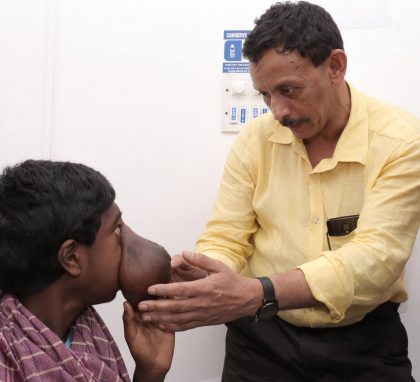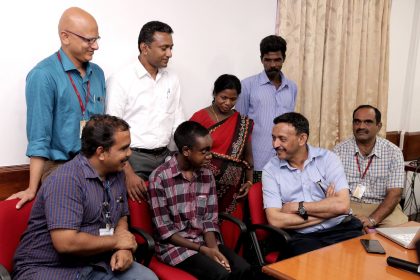- Home
- Editorial
- News
- Practice Guidelines
- Anesthesiology Guidelines
- Cancer Guidelines
- Cardiac Sciences Guidelines
- Critical Care Guidelines
- Dentistry Guidelines
- Dermatology Guidelines
- Diabetes and Endo Guidelines
- Diagnostics Guidelines
- ENT Guidelines
- Featured Practice Guidelines
- Gastroenterology Guidelines
- Geriatrics Guidelines
- Medicine Guidelines
- Nephrology Guidelines
- Neurosciences Guidelines
- Obs and Gynae Guidelines
- Ophthalmology Guidelines
- Orthopaedics Guidelines
- Paediatrics Guidelines
- Psychiatry Guidelines
- Pulmonology Guidelines
- Radiology Guidelines
- Surgery Guidelines
- Urology Guidelines
Amrita Surgeons remove fist-sized ball of brain matter hanging from nose of 13 year old

KOCHI, : A 13-year-old tribal boy Manikandan, son of plantation workers in Parambikulam, Palakkad, was the butt of ridicule since birth because of a rare medical condition called encephlocele in which brain matter oozes out of gaps in the skull into a sac-like structure, giving the patient’s head a grotesque appearance.
A fist-sized ball of brain matter used to hang from Manikandan’s nose as a pendulum. It obstructed his vision and deformed his nose and face. His life changed radically for the better a few days ago when a 10-member team of surgeons at Amrita Institute of Medical Sciences removed the external deformity in a surgery that lasted 11 hours. The entire cost of the procedure was borne by Kerala Government agencies, as Manikandan’s parents, Selvan and Ramata, are from a poor socio-economic background.

Said Dr. Subramania Iyer, Head, Plastic & Reconstructive Surgery, Amrita Institute of Medical Sciences: “It was a complex surgery. Manikandan’s encephlocele was very large which had pushed the bone of his right eye outwards. For surgery, his skull was opened and the normal brain isolated from the sac of non-functioning brain matter hanging from his face. The removal of the deformity left a defect in the skull, a portion of which had to be reconstructed. The patient’s eye sockets were repositioned to remove the deformity in the right eye, and the nose was also remodeled. All these were huge surgical challenges. Manikandan has now recovered fully from the surgery and is ready for discharge. He will now be able to attend school and participate in all social activities like any other child of his age. The surgery was carried out by the combine effort the paediatric craniofacial department consisting of more than 12 surgeons and anesthetists”
The surgical team that operated on Manikandan consisted of paediatric neurosurgeons, craniomaxillofacial surgeons and plastic surgeons, assisted by neuro anaesthetists and a paediatric neuro ICU nursing team. The surgical team was led by Dr Suhas Udaykumar, Dr Pramod Subhash and DR Subramania Iyer and helped by the anesthetic team led by Dr Gokuldas and DR Mathew.
Said Selvan, Manikandan’s father: “We belong to the Marasar tribe and work in a plantation. I have five children, who are all normal and healthy, except Manikandan who was born with a swelling on the nose which kept growing. Because of the huge deformity on his face, he never went to school or mingled with others, as people used to make fun of his appearance. After surgery, he is eager to go back home, start school and make friends. I thank the doctors of Amrita Hospital from the bottom of my heart for enabling him to lead a normal life.”
The district administration of Palakkad and the tribal welfare department stepped in to fund Manikandan’s surgery. Mr. Suresh, District Tribal Welfare Officer, Palakkad, brought the plight of the boy to the attention of Dr. P Pugazhenthi (IFS), Director, Scheduled Tribes Development Department, Kerala. He, in turn, escalated the issue to Mr AK Balan, Hon. Minister for Welfare of Scheduled Castes, Scheduled Tribes and Backward Classes, Government of Kerala. The Minister took keen interest in the matter and sanctioned funds for Manikandan’s surgery. Ms P Marykutty (IAS), District Collector, Palakkad, provided logistical support to liaison between the various Government departments and visited Manikandan at Amrita Hospital to monitor his progress.

Encephalocele is a rare congenital disorder – found in 1 in 5,000 births – in which bones of a baby’s skull do not close completely in the mother’s uterus. This creates an opening through which brain tissue and cerebro-spinal fluid protrudes out of the head in a sac-like structure. The condition can be fatal if the encephalocele hampers development of the brain. Past infancy, patients usually live an isolated life, ashamed to show their face in public.

Disclaimer: This site is primarily intended for healthcare professionals. Any content/information on this website does not replace the advice of medical and/or health professionals and should not be construed as medical/diagnostic advice/endorsement or prescription. Use of this site is subject to our terms of use, privacy policy, advertisement policy. © 2020 Minerva Medical Treatment Pvt Ltd